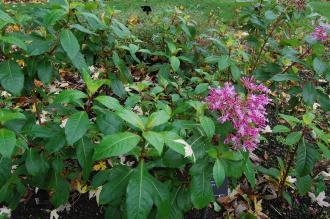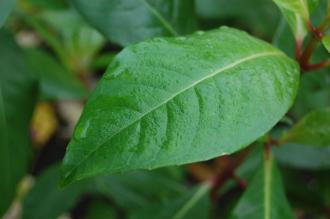
Fuchsia paniculata (08/11/2015, Kew Gardens, London)
Position: Full sun to partial shade
Soil: Moist and well drained
Flowering period: Summer to autumn
Eventual Height: 4m
Eventual Spread: 2.5m
Hardiness: 9a, 9b, 10a, 10b, 11 (it may die back to ground level a the lower end of its hardiness range.)
Family: Onagraceae
Fuchsia paniculata is a evergreen shrub with a bushy habit. Its mid green leaves are lanceolate to ovate with entire margins, up to 15cm long and 5cm across. Its pink/ purple flowers are up to 15mm long and and appear in terminal panicles which are up to 15cm long and 12cm across. Its green/ blue fruit are ellipsoid berries, up to 9mm long and 7mm across.

Fuchsia paniculata Flower (08/11/2015, Kew Gardens, London)
Fuchsia paniculata, occasionally commonly known as Paniculate Fuchsia, is native to the highlands of Central America. In its native habitat it grows in evergreen cloud forests.
The etymological root of the binomial name Fuchsia was named for Leonard Fuchs, a 16th century German botanist. Paniculata is derived from the Latin, referring to the inflorescence taking the form of panicles.

Fuchsia paniculata Leaf (08/11/2015, Kew Gardens, London)
The Landscape architect may find Fuchsia paniculata useful as an attractive summer and autumn flowering shrub. This shrub prefers a sheltered location.
Ecologically, Fuchsia paniculata flowers are attractive to pollinating insects.
Fuchsia paniculata prefers moist, humus rich, well-drained soils. It tolerates most pH of soil.
Fuchsia paniculata requires little to no maintenance. In the UK it may be cut to near ground level in early to mid spring to keep a tidy habit.

Landscape Architecture

